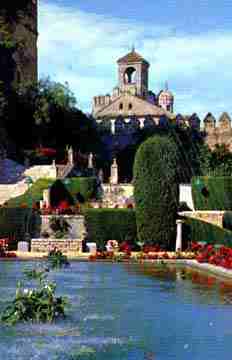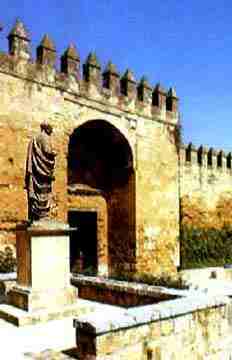|
|
|
|
|
|
|
|
|
|
|
|
|
|
|
|
|
|
|
'History of Andulas' |
|
| Visigothic Spain | ||
|
After the fall of the Roman Empire, Germanic tribes invaded the former empire, several turned sedentary and created successor-kingdoms to the Romans in various parts of Europe. Iberia was taken over by the Visigoths after 410.
|
||
| Al-Andalus | ||
|
In 711 the expanding forces of Islam, founded in the 7th century by prophet Muhammad, after dominating all the north of Africa, took advantage of a civil war in the Visigothic kingdoms in Iberia, jumped the Strait of Gibraltar, and by 718 dominated most of the peninsula. The Moorish advance into Europe was stopped at Poitiers (France) in 732.
The rulers of Al-Andalus were granted the rank of Emir by the Omeya
Calif in Damascus. After the Omeya
were overthrown by the Abbasides Abd-Al-Rahman I declared Cordoba an independent emirate.
Al-Andalus was rife with internal conflict between the Arab Omeya
rulers, the Berbers (North African)
commoners and the Visigoth Christian population. |
||
|
In the 10th century Abd-Al-Rahman III declared the Caliphate of Cordoba, effectively breaking all ties with the Egyptian and Syrian Caliphs. The Caliphate reached its peak around the year 1000, under Al-Mansur (a.k.a. Almanzor), who sacked Barcelona (985) and other Christian cities. After Almanzor's death the Caliphate plunged into a civil war and collapsed into the so-called "Taifa Kingdoms". The Taifa kingdoms lost ground to the Christian realms in the north and, after the loss of Toledo in 1085, the Almoravides invaded Al-Andalus from North Africa and established an empire. In the 12th century the Almoravide empire broke up again, only to be taken over by the Almohade invasion. After the decisive battle of Las Navas de Tolosa in 1212, only the kingdom of Granada remained, until 1492. C�rdoba became one of the most beautiful and advanced cities of Europe, and an important scholarly center. |
 |
|
| Reconquista: 8th-15th centuries | ||
|
The expulsion of the Muslims was started by the first King of Asturias, named Pelayo (718-737), who started his fight against the Moors in the mountains of Covadonga. Later, his sons and descendants continued with his work until all of the Muslims were expelled. While in the east of the peninsula, the Frankish emperors established the Marca Hispanica across the Pyrenees in part of what today is Catalonia, reconquering Girona in 785, Barcelona in 801.
The idea of the Reconquista as a single process
spanning 8 centuries is historically inaccurate. The Christian
realms in northern Spain warred against each other as much as
against the Muslims. El Cid, the 11th-century hero of Spain's epic
poem was banished by king Alfonso VI and found refuge with the
Muslim king of Zaragoza. With the collapse of the Caliphate of
C�rdoba Al-Andalus broke apart into a number of small, warring
domains, which contributed to the success of the southward
expansionist drive of the Christian kingdoms. In the 11th century
the Muslim realms asked for help from the North African Almoravides,
who then took control of all of Al-Andalus and some Christian land.
The Almohades were
The idea of the reconquest as a crusade and the need for
religious purity
in Spain was probably introduced by the "Catholic monarchs" (Reyes
Cat�licos in Spanish) Isabella I of Castile and Ferdinand II of
Aragon in order to justify their invasion of Granada, the expulsion
of the Jews and the forceful conversion of the Moors. |
||
 |
In the 15th century, the Kingdoms of Castile and Aragon united and the Muslims were expelled from the Iberian Peninsula. Aragon was at that time already an important maritime power in the Mediterranean, and Castile was in competition with Portugal for domination of the Atlantic Ocean. After the final conquest of the last Moorish stronghold at Granada in 1492, Spain started financing voyages of exploration. Those of Christopher Columbus brought a New World to Europe's attention, and were followed by the Conquistadores who brought the native empires of Mesoamerica and the Inca under Spanish Control. At the same time, the Jews of Spain were ordered to convert to Christianity or be exiled from the country. Through a policy of alliances with other European nobility and the conquest of most of South America and the West Indies, Spain began to establish itself as an empire. The empire reached its maximum extent under Charles I, who was also (as Charles V) emperor of the Holy Roman Empire.
|
|
| page -1 |
|
For Suggestion, Comments and Queries: